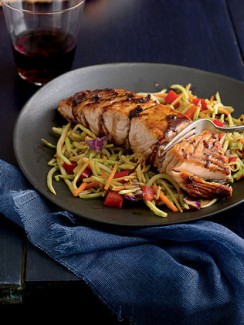Ginger Balsamic Salmon with Hot and Sour Slaw

If you want to add a little spice to your life, try cooking with fresh ginger. I grate it into soups, smoothies, desserts (especially ice cream), preserves and sauces.
When buying fresh ginger, look for heavy pieces with smooth brown skin and no wrinkling or mold. Fresh ginger is hard and breaks cleanly with a snap. If you see pieces with fibers coming out at the break, they’re old.
Ginger can be kept in the refrigerator for two to three weeks wrapped in a paper towel and placed in a plastic bag. Moisture is ginger’s enemy and can cause mold to grow. It can also be wrapped in foil and stored in the freezer for one to two months. It will lose its crispness but will still be flavorful.
To prepare ginger, scrape off the brown skin with a spoon (or leave it on), then chop, slice, grate the flesh using a Microplane grater.
In Chinese cooking, ginger is sliced into julienne, chopped or smashed and added to vegetable, fish and meat dishes. In Japanese cuisine, it’s grated, shredded or pickled and served thinly sliced with sushi. Indian and Pakistani chefs favor it in curries and rice dishes.
We think of ginger as an Asian ingredient, but it has crossed over into many cuisines. You might find it in German cookies, Australian marmalades, Moroccan tagines and American cranberry relish.
Ginger does more than improve taste. It’s also good for you. Traditionally, it has been used to relieve problems with digestion or nausea, including motion sickness. If you like ginger’s warm, pungent flavor, increase the amount used to suit your taste.
A medium-bodied gewurztraminer or riesling or a light lager or ale will pair well with this spicy dish, which I’ve adapted from “Simple Asian Meals” by Nina Simonds (Rodale, $29.99). Serve with brown rice or another whole grain.
For dressing:
1/4 cup soy sauce
3 teaspoon salt
2 tablespoons sugar
2 tablespoons Chinese black vinegar or Worcestershire sauce
For salmon:
4 (6-ounce) pieces center-cut salmon fillet with skin, patted dry
1 teaspoon salt
1/2 teaspoon freshly ground pepper
4 teaspoons canola oil (divided)
1 teaspoon toasted sesame oil
1 teaspoon crushed red pepper flakes
1 medium red bell pepper, cored, seeded and diced
4 tablespoons minced fresh ginger (divided)
3 1/2 cups (9 ounces) shredded broccoli slaw
2 tablespoons rice wine or sake
1/4 cup balsamic vinegar
1 cup water
2 tablespoons freshly squeezed lemon juice
1 1/2 tablespoons light brown sugar
Combine the dressing ingredients and set aside. Season the salmon fillets with salt and pepper.
Heat a wok or a heavy skillet, 2 teaspoons of the canola and the sesame oil until hot but not smoking. Add the red pepper flakes and 2 tablespoons of the ginger, and stir-fry until fragrant, about 10 seconds. Add the diced red pepper and toss lightly over high heat. Add the broccoli slaw, toss lightly and pour in the rice wine. Stir and cover. Cook over medium-high heat for a minute or two. Uncover and add the dressing. Toss lightly and remove to a serving bowl.
Heat the remaining 2 teaspoons oil in a 12-inch, non-stick skillet over medium-high heat. Arrange the salmon fillets in the pan, skin side up, partially cover and sear until well browned, 5 to 6 minutes. Turn the fish over and cook 5 to 6 minutes, until the fish flakes in the middle.
Portion some of the slaw on individual plates, and place salmon fillets on top.
Drain off any oil and reheat the frying pan with the balsamic vinegar, water, lemon juice, brown sugar and remaining 2 tablespoons ginger. Simmer over medium heat-high heat for 1 to 2 minutes until thickened and reduced to 1/3 cup. Carefully pour the glaze over the salmon.
Per serving: 544 calories (56 percent from fat), 33.5 g fat (6.7 g saturated, 13.5 g monounsaturated), 93.5 mg cholesterol, 40 g protein, 18 g carbohydrates, 4.9 g fiber, 1,735 mg sodium.